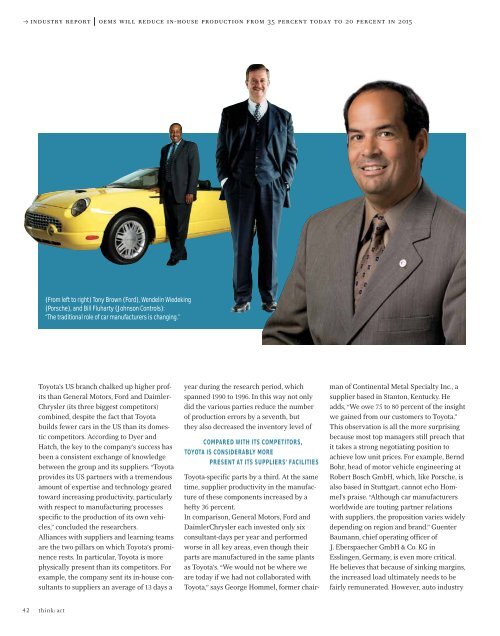issue 1 - Roland Berger
issue 1 - Roland Berger
issue 1 - Roland Berger
You also want an ePaper? Increase the reach of your titles
YUMPU automatically turns print PDFs into web optimized ePapers that Google loves.
p industry report oems will reduce in-house production from 35 percent today to 20 percent in 2015<br />
(From left to right) Tony Brown (Ford), Wendelin Wiedeking<br />
(Porsche), and Bill Fluharty (Johnson Controls):<br />
“The traditional role of car manufacturers is changing.”<br />
Toyota’s US branch chalked up higher profits<br />
than General Motors, Ford and Daimler-<br />
Chrysler (its three biggest competitors)<br />
combined, despite the fact that Toyota<br />
builds fewer cars in the US than its domestic<br />
competitors. According to Dyer and<br />
Hatch, the key to the company’s success has<br />
been a consistent exchange of knowledge<br />
between the group and its suppliers. “Toyota<br />
provides its US partners with a tremendous<br />
amount of expertise and technology geared<br />
toward increasing productivity, particularly<br />
with respect to manufacturing processes<br />
specific to the production of its own vehicles,”<br />
concluded the researchers.<br />
Alliances with suppliers and learning teams<br />
are the two pillars on which Toyota’s prominence<br />
rests. In particular, Toyota is more<br />
physically present than its competitors. For<br />
example, the company sent its in-house consultants<br />
to suppliers an average of 13 days a<br />
year during the research period, which<br />
spanned 1990 to 1996. In this way not only<br />
did the various parties reduce the number<br />
of production errors by a seventh, but<br />
they also decreased the inventory level of<br />
COMPARED WITH ITS COMPETITORS,<br />
TOYOTA IS CONSIDERABLY MORE<br />
PRESENT AT ITS SUPPLIERS’ FACILITIES<br />
Toyota-specific parts by a third. At the same<br />
time, supplier productivity in the manufacture<br />
of these components increased by a<br />
hefty 36 percent.<br />
In comparison, General Motors, Ford and<br />
DaimlerChrysler each invested only six<br />
consultant-days per year and performed<br />
worse in all key areas, even though their<br />
parts are manufactured in the same plants<br />
as Toyota’s. “We would not be where we<br />
are today if we had not collaborated with<br />
Toyota,” says George Hommel, former chairman<br />
of Continental Metal Specialty Inc., a<br />
supplier based in Stanton, Kentucky. He<br />
adds, “We owe 75 to 80 percent of the insight<br />
we gained from our customers to Toyota.”<br />
This observation is all the more surprising<br />
because most top managers still preach that<br />
it takes a strong negotiating position to<br />
achieve low unit prices. For example, Bernd<br />
Bohr, head of motor vehicle engineering at<br />
Robert Bosch GmbH, which, like Porsche, is<br />
also based in Stuttgart, cannot echo Hommel’s<br />
praise. “Although car manufacturers<br />
worldwide are touting partner relations<br />
with suppliers, the proposition varies widely<br />
depending on region and brand.” Guenter<br />
Baumann, chief operating officer of<br />
J. Eberspaecher GmbH & Co. KG in<br />
Esslingen, Germany, is even more critical.<br />
He believes that because of sinking margins,<br />
the increased load ultimately needs to be<br />
fairly remunerated. However, auto industry<br />
42<br />
think: act
















